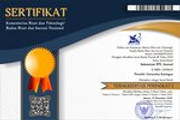BRIDGING CRITICAL DISCOURSE ANALYSIS IN MEDIA DISCOURSE STUDIES
Abstract
The precarious and critical period of the initiation of Discourse Analysis was populer at the end of the 1990s and the beginning of 2000s. Various approaches and frameworks were proposed during the time especially in the field of Applied Linguistics. This is including Critical Discourse Analysis (CDA) as one of its leading areas. This present study aimed at exploring and catching out how the CDA’ presentation in overall related to Media studies and how it can be applicable to uncover an unseen ideologies while examining the existence of media discourse studies. The study is considering 25 journal studies to scrutinize the ways and methods used in discern social phenomena while illuminating the true characteristics of the social actors. As result, it was revealed that CDA is used openly to expose ideologies that somehow differentiate oppressed groups by offering a dummy image used by the highest authority or elite.
Keywords: CDA; ideology; media discourse; social actors; power.
Full Text:
PDFReferences
Ahmadian, M., & Farahani, E. (2014). A critical discourse analysis of the los angeles times and tehran times on the representation of Iran’s nuclear program. Theory and Practice in Language Studies, 4(10), 2114-2122.
Azad, O. (2013). Critical discourse analysis of 20: 30 news broadcasting. Modern Journal of LanguageTeaching Methods, 3(2), 78.
Behnam, B., & Mahmoudy, B. (2013). A critical discourse analysis of the reports issued by the International Atomic Energy Agency (IAEA) Director General on Iran's nuclear program during the last decade. Theory and Practice in Language Studies, 3(12), 2196-2201.
Bolte, S. & Keong, Y. C. (2014). The refugee swap deal in malaysian online news reports: Ideology and representation. GEMA Online of Language Studies, 14(2), 93-108. http://dx.doi.org/10.17576/GEMA-2014-1402-07
Fairclough, N. (1992). Discourse and social change (Vol. 73). Cambridge: Polity Press.
Fairclough N (1995). Critical discourse analysis: The critical study of language. London: Longman.
Fairclough, N. (2009). A dialectical-relational approach to critical discourse analysis in social research. In Fowler, R. (1991). Critical linguistics. In K. Halmkjaer (Eds.), The linguistic encyclopedia (pp. 89–93). London: Routledge.
Fauzan, U., Subroto, H. E., & Poedjosoedarmo, S. (2014). A CDA of the ideology of Indonesian metro tv news report. International Journal of Linguistics, 6(4), 71-86.
Hamuddin, B. (2012). A comparative study on politeness strategies in economic text. Master thesis. Kuala Lumpur: University of Malaya.
Hamuddin, B. (2015). Discourse on media: Bringing hot news into ELT’s classroom discussion. Pekanbaru: Lancang Kuning University.
Hamuddin, B. (2016). Job vacancy discourse: Seeking an opportunity for English department alumni in newspapers. Jurnal Ilmu Komunikasi (JIK), 14(2).
Iqbal, A., Danish, M. H., & Tahir, M. R. (2014a). Exploitation of women in beauty products of fair and lovely: A critical discourse analysis study. International Journal of Studies in English Language andLiterature, 2(9), 122-131.
Jorgensen, M. W., & Phillips, L. J. (2002). Discourse analysis as theory and method. London: Sage.
Kaur, K., Arumugam, N., & Yunus, N. M. (2013). Beauty product advertisements: A critical discourse analysis. Asian Social Science, 9(3), 61-71.
Kerr, P. K. (2009). Iran’s nuclear program: Tehran compliance with international obligations. USA: DIANE Publishing.
Mayasari, M., Darmayanti, N., & Riyanto, S. (2013). Critical discourse analysis of reporting on "Saweran for KPK building" in media Indonesia daily newspaper. International Journal of Linguistics, 5(4), 213-224.
Reisigl, M., & Wodak, R. (2009). The discourse-historical approach (DHA). In R. Wodak, & M. Meyer (Eds.), Methods of critical discourse analysis (pp 87-121). Thousand Oaks: Sage.
Tahmasbi, S., & Kalkhajeh, S. G. (2013). Critical discourse analysis: Iranian banks advertisements. Asian Economic and Financial Review, 3(1), 124-145.
Vahid, H., & Esmae’li, S. (2012). The power behind images: Advertisement discourse in focus. International Journal of Linguistics, 4(4), 36-51.
Van Dijk, T. A. (1987). Episodic models in discourse processing. In R. Horowitz & S.J. Samuels, (Eds.), Comprehensive oral and written language (pp.161-196). New York: Academic Press.
Van Dijk, T. A. (1990). Discourse & society: A new journal for a new research focus. London: Sage Social Collection.
Van Dijk, T. A. (1995). Discourse analysis as ideology analysis. Language and Peace, 10, 47-142.
Van Dijk, T. A. (1998). Ideology: A multidisciplinary study. London: Sage.
Van Dijk, T. A. (2000). Ideology and discourse: A multidisciplinary introduction. Barcelona.
Van Dijk, T. A. (2001). Critical discourse analysis. In D. Schiffrin, D. Tannen, & H. Hamilton (Eds.), (pp. 352-371).
Van Dijk, T. A. (2003). 18 Critical discourse analysis. In D. Tannen, D. Schiffrin, & H. Hamilton (Eds.), Handbook of discourse analysis (pp. 352-371). Oxford: Blackwell.
Van Dijk, T. A. (2009). Critical discourse studies: A sociocognitive approach. Methods of Critical Discourse Analysis, 2(1), 62-86.
Wodak, R., & Meyer, M. (2009). Critical discourse studies: A sociocognitive approach. In R. Wodak, & M. Meyer (Eds.), Methods of critical discourse analysis (pp 162-187). Thousand Oaks: Sage.
Wodak, R., & Busch, B. (2004). Approaches to media texts. In J. Downing (Eds.), Handbook of media studies. London: Sage.
Zhang, M. (2014). A critical discourse analysis of political news reports. Theory and Practice in Language Studies, 4(11), 2273-2277.
DOI: https://doi.org/10.25134/ieflj.v4i2.1379
Refbacks
- There are currently no refbacks.

This work is licensed under a Creative Commons Attribution-ShareAlike 4.0 International License.

